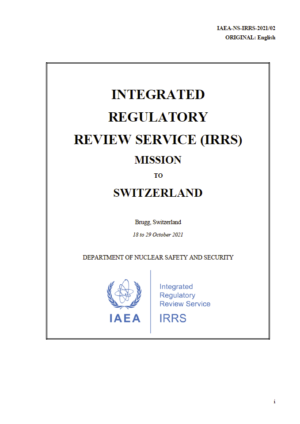In its final report, the IRRS Mission calls for a national competence management strategy
The International Atomic Energy Agency (IAEA) has presented its final report on the review of nuclear oversight in Switzerland. The conclusion: ENSI acts as an independent and progressive regulatory authority in accordance with internationally applicable safety standards. The IRRS Mission 2021 team of experts sees the greatest challenge for oversight in Switzerland as the long-term competence management in the area of nuclear safety.
“ENSI is considered a mature and competent regulator with a high level of independence which ensures it is able to fulfil its statutory obligations without undue influence.” This is the conclusion of the IAEA experts in their final report on the IRRS Mission in Switzerland.
As a member state of the International Atomic Energy Agency (IAEA), Switzerland makes use of its Integrated Regulatory Review Service (IRRS) for the purpose of reviewing nuclear oversight. Pursuant to the ENSI Ordinance Art. 2 para. 3, ENSI is obliged to undergo an international review every ten years.
The IRRS Mission 2021 in brief
The 2021 IRRS mission took place in Switzerland from 18 to 29 October with the aim of reviewing nuclear oversight. Among other things, the team of experts assembled by the International Atomic Energy Agency (IAEA) interviewed ENSI employees, nuclear plant operators, representatives of various national authorities and organisations, met with representatives of a Swiss NGO and accompanied ENSI specialists during inspections in regulated installations.
“On the one hand, this external assessment ensures that our oversight work is putting the IAEA regulations into practice. On the other hand, recommendations from international experts on issues highlighting room for improvement are valuable for our work,” said ENSI Director General Marc Kenzelmann on 18 October 2021 at the start of the IRRS mission.
An IRRS mission essentially comprises two parts: firstly, the preliminary self-assessment of the national regulatory system and, secondly, the review during the mission by a team of international experts assembled by the IAEA.
The IRRS mission in Switzerland prior to this took place in 2011, the corresponding follow-up review mission in 2015.
From 18 to 29 October 2021, experts from the International Atomic Energy Agency (IAEA) obtained a detailed picture of ENSI’s work within the framework of the IRRS Mission and thoroughly put ENSI under the microscope. At the concluding meeting on 29 October 2021, the team of experts could confirm that the Swiss oversight, including its regulatory and legal framework, was in the interests of nuclear safety. The final report of the IRRS Mission in Switzerland is now available.
Improvement suggestions for ENSI and the Federal Government
The team of experts made seven recommendations and 13 suggestions for improvement. Based on international comparison, ENSI demonstrated good practice in two separate areas.
The team of experts considers that the greatest challenge in Switzerland, is maintaining and building competence of the parties responsible for safety in the long term, particularly against the backdrop of the phasing out of nuclear energy. The Swiss government should evaluate the need for specialist knowledge and take measures to ensure the safety of operating nuclear installations, decommissioned nuclear installations and the deep geological storage of radioactive waste.
Further improvement suggestions addressed to the Federal Government:
- Set up legal provisions that also allow prosecution of a licensee instead of an individual,
- Establish a binding obligation for the authorised parties to inform the public about safety-relevant occurrences associated with the operation of their facilities, and
- Create a legal basis to ensure that all nuclear facilities will be subject to periodic safety reviews in accordance with a graded approach.
Improvement suggestions directed at ENSI:
- Update the enforcement procedures for clarifying the roles of inspectors in the enforcement process, including in relation to immediate corrective actions inspectors are authorised to take,
- Further harmonisation of ENSI’s regulatory guides with the IAEA safety standards, and
- Further revision of the management system.
Good practice in respect of the regulatory culture and internal safety culture
In the final report, ENSI’s continuously developed and improved safety culture was highlighted as a first example of good practice. A second example was the manner in which ENSI promotes the safety culture of the licensees through holding periodic dialogues in format of focus groups with the senior leadership teams and safety culture specialists of the NPP licensees.
In addition, Switzerland received good marks, for, amongst other things:
- The role of ENSI in implementing the regulatory policy and the associated requirements for continued safety improvement at nuclear power plants,
- The anticipated dialogue and collaboration among all Federal and Cantonal authorities involved in the licensing process of nuclear facilities, and
- The periodic personal security background tests for ENSI’s staff, including evaluation of possible lack of impartiality.
ENSI will address the suggestions for improvement from the IRRS Mission together with the authorities concerned. In the coming years, the IAEA will undertake a follow-up mission to obtain an overview of developments.


